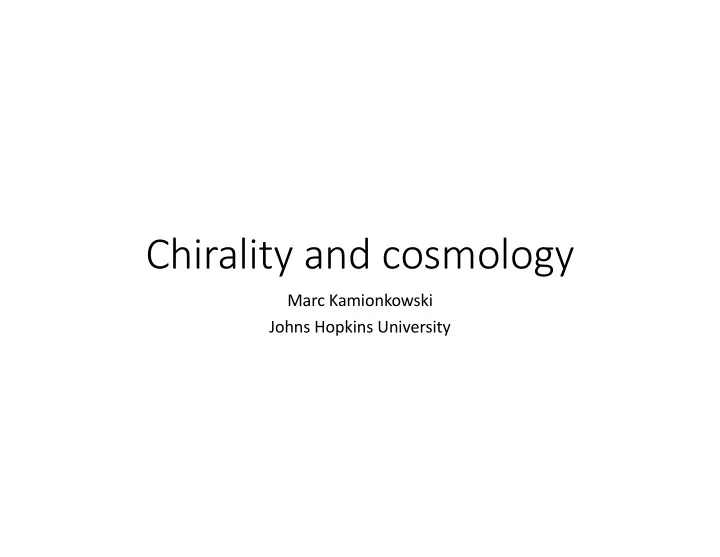

Chirality and cosmology Marc Kamionkowski Johns Hopkins University
The gist • Fundamental interactions are parity breaking • maybe parity breaking is manifest in new cosmological physics (inflation, dark matter, dark energy, baryogenesis) as well?
Elegant mathematics Themes Proofs of principle Some New observables futuristic/academic Some possibly observable
Subjects • Circular polarization of the CMB • From density perturbations • From gravitational waves • From chiral gravitational-wave background • Chiral gravitational waves • Pulsar timing arrays • Astrometry • 21-cm polarization
collaborators • CMB: Keisuke Inomata • PTAs/astrometry: Selim Hotinli, Kim Boddy, Wenzer Qin, Liang Dai, Andrew Jaffe, Enis Belgacem • 21-cm: Lingyuan Ji, Keisuke Inomata • TAM formalism: Liang Dai, Donghui Jeong
Cosmic microwave background
Linearly polarized by anisotropic Thomson scattering
Circular polarization of CMB • Does not arise at linear order in cosmological perturbations • Linear polarization from scattering of anisotropic radiation field • Circular polarization arises at second order from photon-photon interactions anisotropic CMB background gives rise to anisotropic index of refraction that a given CMB photon passes through (Sawyer 2014; Montero-Camacho & Hirata, 2018)
But what about circular polarization • Does not arise at linear order in cosmological perturbations (Thomson scattering induces only *linear* polarization)
But can be induced by propagation of linearly polarized light through birefringent medium
Primordial density perturbations
Now suppose primordial polarization or index-of- refraction tensor due to primordial GWs • Polarization and index of refraction now have B (as well as E) modes:
Probably far from detectable
Chiral photons from chiral GWs
Pulsar timing arrays and gravitational waves
Consider + polarized GW in +z direction
<latexit sha1_base64="xQe3O6ogpr2giAP9qb9Dl8tMwI=">ACIHicbZDLSsNAFIYnXmu9RV26GSxC3ZREKnUjFN24rGAv0IQwmU7aoTNJmJkUS+ijuPFV3LhQRHf6NE7aFLT1wMDH/5/DmfP7MaNSWdaXsbK6tr6xWdgqbu/s7u2bB4ctGSUCkyaOWCQ6PpKE0ZA0FVWMdGJBEPcZafvDm8xvj4iQNArv1TgmLkf9kAYUI6Ulz6w58YCWnRHB8OEMXkFHJtxLh4xPYObMsSFznLd6ZsmqWNOCy2DnUAJ5NTz0+lFOEkVJghKbu2FSs3RUJRzMik6CSxAgPUZ90NYaIE+m0wMn8FQrPRhEQr9Qwan6eyJFXMox93UnR2ogF71M/M/rJiq4dFMaxokiIZ4tChIGVQSztGCPCoIVG2tAWFD9V4gHSCsdKZFHYK9ePIytM4rdrVycVct1a/zOArgGJyAMrBDdTBLWiAJsDgETyDV/BmPBkvxrvxMWtdMfKZI/CnjO8f9Uyi4A=</latexit> <latexit sha1_base64="HSTMThdemOyUrYUP4HS/f9g0xME=">ACHnicbVDLSsNAFJ34rPUVdelmsAjtpiTSohuh6MZlBfuQJobJdNKOmTyYmRL6Je48VfcuFBEcKV/4zTNQlsPDBzOZc797gxo0Iaxre2tLyurZe2Chubm3v7Op7+20RJRyTFo5YxLsuEoTRkLQklYx0Y05Q4DLScf3Lqd8ZES5oFN7IcUzsA1C6lGMpJIcvW41BXVSnwWTsjUiGD5U4DmsQSumkN4xeO+ws8r8NZJs8gQSRVx9JRNTLARWLmpARyNB390+pHOAlIKDFDQvRMI5Z2irikmJFJ0UoEiRH20YD0FA1RQISdZudN4LFS+tCLuHqhJn6eyJFgRDjwFXJAMmhmPem4n9eL5HemZ3SME4kCfFskZcwKCM47Qr2KSdYsrEiCHOq/grxEHGEpWq0qEow509eJO2Tqlmr1q9rpcZFXkcBHIjUAYmOAUNcAWaoAUweATP4BW8aU/ai/aufcyiS1o+cwD+QPv6AdfFoHI=</latexit> <latexit sha1_base64="r7vn7xvk8LD8PZE1X7I/F4sfj0s=">ACNHicbVDJSgNBEO1xN25Rj14Kg6CXMCOKXgTRi+BFwSRCJoaenop0rPQXSOGIR/lxQ/xIoIHRbz6DXYWcH3Q8N6rKqrBamShlz3yRkbn5icmp6ZLczNLywuFZdXqibJtMCKSFSiLwNuUMkYKyRJ4WqkUeBwlrQOe7XazeojUziC+qm2Ij4dSxbUnCyVrN46qdtuenfoIDbLTgA32RMx/oTg98kipE+OrpbAFe5SBhqMAXYUJDcdtrFktu2R0A/hJvREpshLNm8cEPE5FGJNQ3Ji656bUyLkmKRT2Cn5mMOWiw6+xbmnMIzSNfHB0DzasE0Ir0fbFBAP3+0TOI2O6UWA7I05t87vWN/+r1TNq7TdyGacZYSyGi1qZAkqgnyCEUqMg1bWECy3tX0G0ueaCbM4FG4L3+S/pLpd9nbKu+c7pcOjURwzbI2ts03msT12yE7YGaswe7YI3thr8698+y8Oe/D1jFnNLPKfsD5+AQS86lN</latexit> Total angular momentum waves • Standard approach k ) e i ~ ˜ � ( ~ X k · ~ x � ( ~ x ) = ~ k X � ( ~ x ) = � klm Ψ klm ( ~ x ) klm x ) = 4 ⇡ i l j l ( kr ) Y lm (ˆ Ψ klm ( ~ x )
• Analogous expansions for vector fields in terms of three types (E, B, L) of vector TAM waves • Analogous expansions for STF tensor fields in terms of 5 types (L, VE, VB, TE, TB) of tensor TAM waves. Transverse-traceless are TE/TB • TAM formalism far more powerful for vector/tensor fields (than for scalar) given the transformation properties (the “spin”) of these fields under rotations
For PTA/astrometry • Is trivial to consider contribution of any given TAM wave to PTA/astrometry observables
GW anisotropy with PTAs
Bottom line • Isotropic signal must be established with high SNR before anisotropy can be detected, and then only if anisotropy amplitude is O(1).
Back to chirality!! • Anisotropy estimator easily modified to seek GW circular-polarization
• Anisotropy - à CP :: + à - • L+l+l’ = even à L+l+l’ = odd • So estimators for intensity anisotropy become estimators for circular- polarization anisotropy by placing L+l+l’ even to L+l+l’ odd • One consequence: monopole (an overall GW chirality) not detectable • Numerically, CP dipole detectable with high SNR and for CP dipole O(1)
This is interesting! • ~nHZ GW background from SMBH-binary mergers • Local signal may well be dominated by one, or a handful of sources, and if so, intensity should be anisotropic, and signal most generally circularly polarized to O(1)
Circular polarization of 21-cm radiation from dark ages • Hirata, Mishra & Venumadhav (2017) calculated circular polarization from 21-cm line of neutral hydrogen from misalignment of 21-cm quadrupole and CMB quadrupole. Calculation performed with spherical tensors. • Our work (in progress): reformulate in terms of Cartesian tensors and then use TAM to simplify calculation. Provide first numerical results on “standard model” prediction (that arises from 2 nd order in density- perturbation amplitude)
arXiv:2005.10250
Numerically…. • Signal far too big to be seen any time soon, but conceivably detectable with future lunar-based radio array • May be interesting cross-correlations with other observables (CMB B mode, weak lensing, etc.)
Summary/conclusions • Calculational tools from TAM formalism allow dramatic simplification of observables on a spherical sky, especially when vector/tensor modes are involved and/or observables are 2 nd order in perturbation theory • CMB circular polarization in standard model • Imprint of chirality of GW background on CMB CP • Elegant/compact formalism for PTA/astrometry probes of ~nHZ GW background • CP of 21-cm radiation from dark ages
Recommend
More recommend